How and what makes the soldering of polypropylene pipes with
With the use of new materials for the production of domestic water pipes, the process of their installation has become much simpler. Due to this, polypropylene water pipelines are gaining more and more popularity, confidently displacing steel and cast iron. The article will be devoted to how to solder polypropylene pipes with their own hands.
Having knowledge of the technology of their connection, requirements for installation, as well as having the necessary set of tools and parts, it is quite possible to install the water supply or sewage system yourself in a house or apartment. We will talk about this below.
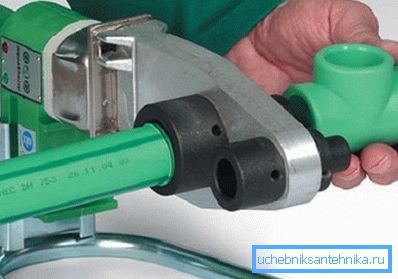
Materials and tools
The quality of the used parts and tools depends on the duration of the trouble-free operation of the system of polypropylene (PP) pipes. The selection of pipes and fittings must be made taking into account the type of water supply (cold or hot). For manufactured pipes PP now has the following classification:
| PN-10 | Apply only to supply cold water. Permissible operating temperature range from 0 to 40 ° С. The price of products is the cheapest. |
| PN-20 | Used for cold-water and hot-water. The walls of the pipe are reinforced with fiberglass. |
| PN-25 | Used for the installation of heating systems. Maintain the temperature of the coolant to + 95 ° C (some modifications are resistant to short-term exposure to + 110 ° C). |
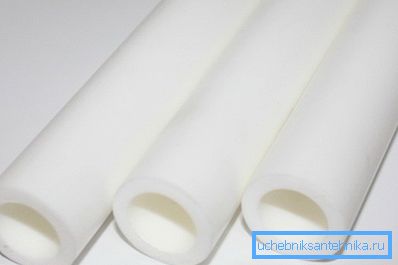
To provide connections and forks of the plumbing system use special parts:
- angles with the angle of rotation of the pipe at 90 ° and 45 °. If the installation on the angular rotation of the threaded fitting is necessary, the corresponding components with internal or external threads are taken;
- the coupling serves for joining the ends of the pipes to each other. They are straight (for pipes with the same diameter) and transitional;
- tees and crosses - for connecting three and four pipes, respectively, with the same or with different diameters;
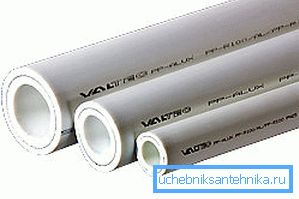
- stop valves - cranes of different types;
- threaded end fittings;
- fittings - for connecting a flexible hose;
- stubs - for sealing pipe ends.
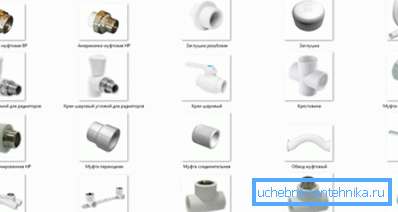
Tip: note that each of the parts has a specific purpose and can be used in the construction of the pipeline together with others, depending on the need.
The connection of PP with other elements and between them occurs through welding.
The following tools are required to complete this process:
- welding device. Manual, semi-automatic and automatic models are used for welding pipes of various types and diameters. To perform small amounts of work on the connection of small-diameter pipes, a manual welding device with a set of nozzles is quite suitable;
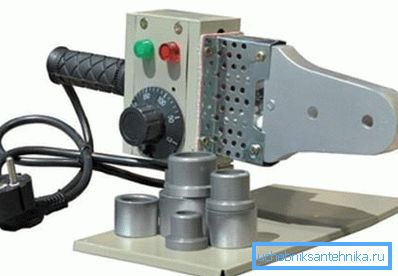
- special scissors - for trimming pipes to the desired size;
- for mounting the P-20 and P-25 (reinforced) you will need a special tool to prepare the ends. It removes the reinforcing layer from the surface of the soldering pipe.
Soldering machine
Based on the material and diameter of the pipe, the appropriate apparatus is selected.
Currently the following types are common:
- manual with a heating element in the form of a metal disk with a heater. The surface is coated with Teflon to prevent plastic from sticking during heating;
- manual welding device with coupling elements, designed for socket welding of pipes. It is the most popular soldering iron for connecting PP pipes;
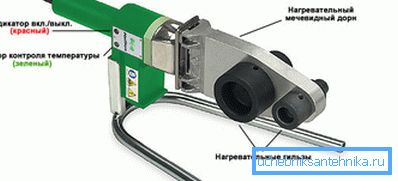
- welding machines for butt welding - are quite complex complexes for the preparation and connection of plastic pipes with a large diameter. They are used mainly for the installation of long pipelines on an industrial scale.
For soldering pipes of small diameter, soldering irons with heating elements and special nozzles are used to ensure uniform heating of the PP pipes at the junction.
Soldering tips
Nozzles for soldering irons must meet the following technical requirements:
- high mechanical strength;
- high thermal conductivity;
- do not change their linear dimensions in the working temperature range.
Almost all welding devices provide the ability to install multiple nozzles at the same time. This speeds up the installation work - there is no need to wait for the soldering iron to cool to replace the nozzle.
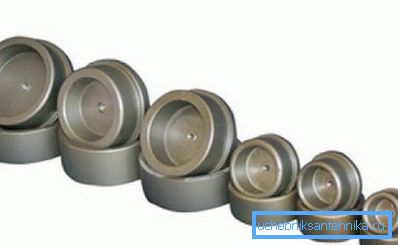
The product consists of two elements - for the outer (sleeve) and internal heating (mandrel) surface of the PP pipe.
The material for the manufacture can be any metal alloy that meets the above requirements. In order to avoid sticking of the heated plastic to the surface of the nozzle, it is coated with Teflon.
Tip: remember that the sizes of nozzles are individual for pipes of different diameters.
Preparatory work
Before starting to weld pipes, it is necessary to carry out work aimed at ensuring compliance with the soldering technology:
- before soldering the room is ventilated and dust is removed. Bulk materials are removed from the welding area, as they can settle on the heated surfaces of the pipes, which will lead to a deterioration in the quality of the seam. The temperature in the room should be in the range of 18 ° C to 30 ° C. It is also necessary to provide forced ventilation;
- Pre-compiled piping diagram indicating the lengths of pipe sections and a set of all components. For all connecting elements, the soldering depth is indicated, which is important to consider when marking, therefore the depth of the welded part is added to the linear dimension;
- for work you will need a tape measure, ruler, angle and clean rags;
- The required attachments are mounted on the welding device and only then connected to the power grid.
After these activities, you can proceed directly to the installation.
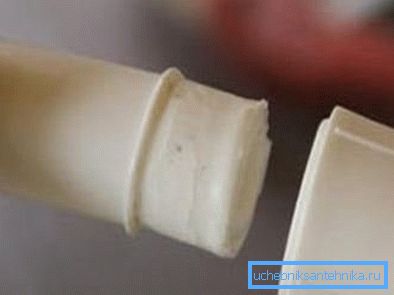
Welding technology
- The instruction for soldering polypropylene pipes is based on the method of fusing pipe parts with each other during heating. Currently, several welding methods are used, including diffuse and socket-shaped. The use of any of the methods should be selected for specific works.
Diffuse
The method is based on the counter penetration of the materials of the two elements being joined during heating. It is due to diffusion that a solid connection of PP pipes occurs at the molecular level.
Tip: this method is relevant for welding elements only from homogeneous materials.
It is carried out using various types of welding devices. The main task is to ensure that the soldering temperature of polypropylene pipes reaches + 260 ° С.
Trumpet
The process is based on the use of welding devices with nozzles.
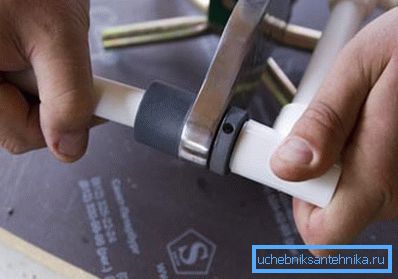
Heating and connection of pipeline elements occurs in stages:
| Training | The pipe is cut to the specified size. If it is reinforced, then welding of the welding ends is necessary. The pipe cut must be strictly at an angle of 90 ° to ensure maximum contact plane during welding. On the surface of the pipe marking is applied, corresponding to the depth of welding. |
| Welding | At the same time, the welded elements of the pipeline are inserted into the mandrel and sleeve. Here they are located for a certain time for heating (the exposure time depends on the characteristics of the pipe material, their diameter and the power of the soldering iron), and then the heated ends are interconnected. |
| Cooling down | Allow time for the structure to cool down without making a mechanical impact on it, as this may interfere with the process of fusing the heated parts of the pipeline. |
Conclusion
New materials today give home craftsmen the opportunity to independently produce plumbing and heating systems using a minimum set of tools. In our case, it was a soldering iron to work with PP pipes, with which, with a certain skill, you can forget about hired workers.
The article was about what it is and how to use it. The video in this article will help you find additional information on this topic.